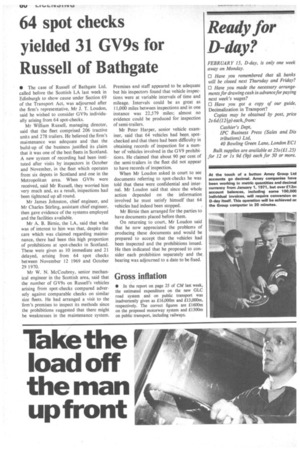64 spot checks yielded 31 GV9s for Russell of Bathgate
Page 62

If you've noticed an error in this article please click here to report it so we can fix it.
• The case of Russell of Bathgate Ltd, called before the Scottish LA last week in Edinburgh to show cause under Section 69 of the Transport Act, was adjourned after the firm's representative, Mr J. T. Loudon, said he wished to consider GV9s individually arising from 64 spot-checks. Mr William Russell, managing director, said that the fleet comprised 206 tractive units and 278 trailers. He believed the firm's maintenance was adequate and that the build-up of the business justified its claim that it was one of the best fleets in Scotland. A new system of recording had been instituted after visits by inspectors in October and November, in the fleet which operates from six depots in Scotland and one in the Metropolitan area. When GV9s were received, said Mr Russell, they worried him very much and, as a result, inspections had been tightened up all round.
Mr James Johnston, chief engineer, and Mr Charles Stirling, assistant chief engineer, then gave evidence of the systems employed and the facilities available.
Mr A. B. Birnie, the LA, said that what was of interest to him was that, despite the care which was claimed regarding maintenance, there had been this high proportion of prohibitions at spot-checks in Scotland. These were given as 10 immediate and 21 delayed, arising from 64 spot checks between November 12 1969 and October 29 1970.
Mr W. N. McCoubrey, senior mechanical engineer in the Scottish area, said that the number of GV9s on Russell's vehicles arising from spot-checks compared adversely against comparable checks on similar size fleets. He had arranged a visit to the firm's premises to inspect its methods since the prohibitions suggested that there might be weaknesses in the maintenance system. Premises and staff appeared to be adequate but his inspectors found that vehicle inspections were at variable intervals of time and mileage. Intervals could be as great as 11,000 miles between inspections and in one instance was 22,579 miles; almost no evidence could be produced for inspection of semi-trailers.
Mr Peter Harper, senior vehicle examiner, said that 64 vehicles had been spotchecked and that there had been difficulty in obtaining records of inspection for a number of vehicles involved in the 0V9 prohibitions. He claimed that about 90 per cent of the semi-trailers in the fleet did not appear to have records of inspection.
When Mr Loudon asked in court to sec documents referring to spot-checks he was told that these were confidential and internal. Mr Loudon said that since the whole action depended on the information involved he must satisfy himself that 64 vehicles had indeed been stopped.
Mr Bimie then arranged for the parties to have documents placed before them.
On returning to court, Mr Loudon said that he now appreciated the problems of producing these documents and would be prepared to accept that the vehicles had been inspected and the prohibitions issued. He then indicated that he proposed to consider each prohibition separately and the hearing was adjourned to a date to be fixed.
Gross Inflation
• In the report on page 25 of CM last week, the estimated expenditure on the new GLC road system and on public transport was inadvertently given as £16,000m and £13,000m, respectively. The correct figures are il600m on the proposed motorway system and £1300m on public transport, including railways.






































































































































































